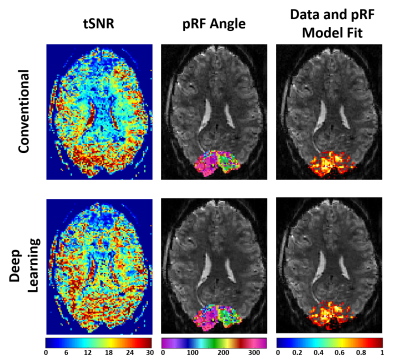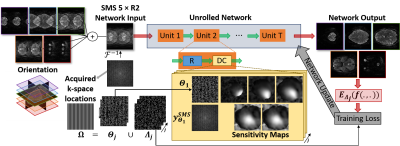Omer Burak Demirel1,2, Burhaneddin Yaman1,2, Steen Moeller2, Logan Dowdle2, Luca Vizioli2, Kendrick Kay2, Essa Yacoub2, John Strupp2, Cheryl Olman2, Kâmil Uğurbil2, and Mehmet Akçakaya1,2
1Electrical and Computer Engineering, University of Minnesota, Minneapolis, MN, United States, 2Center for Magnetic Resonance Research, University of Minnesota, Minneapolis, MN, United States
1Electrical and Computer Engineering, University of Minnesota, Minneapolis, MN, United States, 2Center for Magnetic Resonance Research, University of Minnesota, Minneapolis, MN, United States
A self-supervised physics-guided
deep learning reconstruction for highly-accelerated HCP-style fMRI was
implemented to reduce noise amplification, while also showing that deep
learning reconstruction does not adversely affect fMRI analysis.

Figure 4: Results from analysis of a
testing dataset. Our self-supervised deep learning shows improved tSNR (left)
compared to conventional reconstruction. The angular maps (middle), and the
correlation between time-series data and the pRF model fit thresholded at 0.2
(right), both masked to occipital love, show no meaningful differences,
suggesting no loss in functional spatial precision or subtle temporal effects
with the deep learning method.

Figure 1: A schematic of the self-supervised
approach used in this study, which does not require fully-sampled data. The unrolled neural network incorporates the
encoding operator via data consistency steps. A ResNet is used for non-linear
regularization. The data split ($$$\Theta,\Lambda$$$) of the acquired k-space locations ($$$\Omega$$$)
allow training without fully-sampled data, which has been a main hindrance for
DL reconstruction for fMRI.